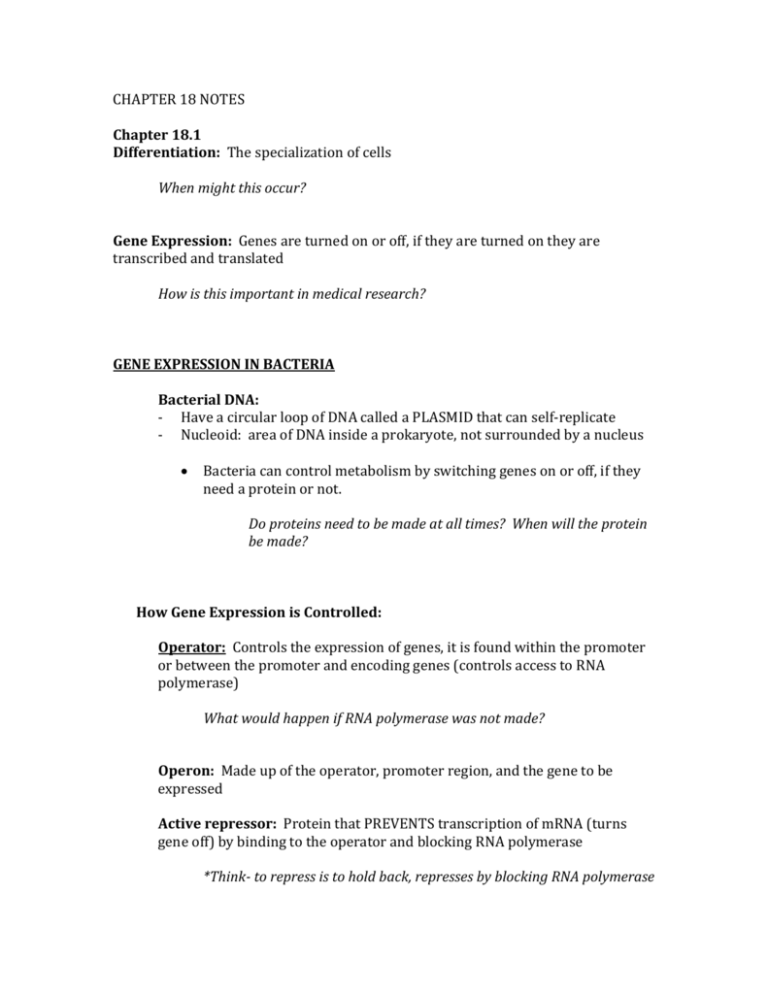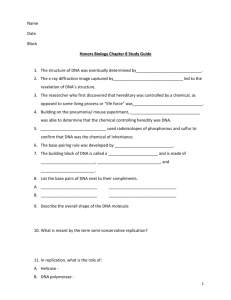chapter 18 notes
advertisement

CHAPTER 18 NOTES Chapter 18.1 Differentiation: The specialization of cells When might this occur? Gene Expression: Genes are turned on or off, if they are turned on they are transcribed and translated How is this important in medical research? GENE EXPRESSION IN BACTERIA Bacterial DNA: - Have a circular loop of DNA called a PLASMID that can self-replicate - Nucleoid: area of DNA inside a prokaryote, not surrounded by a nucleus Bacteria can control metabolism by switching genes on or off, if they need a protein or not. Do proteins need to be made at all times? When will the protein be made? How Gene Expression is Controlled: Operator: Controls the expression of genes, it is found within the promoter or between the promoter and encoding genes (controls access to RNA polymerase) What would happen if RNA polymerase was not made? Operon: Made up of the operator, promoter region, and the gene to be expressed Active repressor: Protein that PREVENTS transcription of mRNA (turns gene off) by binding to the operator and blocking RNA polymerase *Think- to repress is to hold back, represses by blocking RNA polymerase Regulatory Gene: Located elsewhere in the bacterial DNA (from the operon it controls) and codes for the active repressor protein If the regulatory gene was turned off, would the repressor protein be made? Would the RNA polymerase be inactivated? Corepressor: a small molecule that binds to a repressor and activates it *Some repressor proteins are active on their own, so don’t need a corepressor to activate BUT - An INDUCER binds to them and inactivates the repressor Why are inducers necessary? If inducers didn’t exist for respressors that were active on their own, what would happen? In the top part of the picture above, - The regulatory gene is ___________________________. - The repressor is ________________________. Does it need to bind to a corepressor to be active, or is it active on its own? - The repressor binds to the ______________________, and ____________ __________________ is blocked. In the bottom part of the picture, - Explain why RNA polymerase can bind to the promoter region and transcribe the sequence: - The molecule of lactose is acting as a _____________________, putting the repressor into its inactive form. This pictures explains the Lac Operon (In E.Coli) - Lactose is available to E. coli in human colon if host drinks milk - E. coli can metabolize lactose into glucose and galactose - B- galactosidase is enzyme that catalyzes the breakdown of lactose - The gene for this enzyme is part of the LAC OPERON - Lac1 is the regulatory gene that codes for an allosteric repressor protein that can switch off lac operon by binding to operator. - Typically, gene is turned off, repressor is active on its own, BUT - When lactose is present, allolactase (isomer of lactose), acts as a n inducer and INACTIVATES the repressor protein and gene is transcribed in order to metabolize lactose. *The top picture shows what happens usually, without lactose, the bottom picture shows what happens when lactose is present. *SEE PICTURE ON NEXT PAGE FOR CLARIFICATION AND AGAIN… WHEN LACTOSE IS PRESENT AND GLUCOSE IS SCARCE - When glucose and lactose are present, E. coli prefer glucose - Cyclic AMP (cAMP) , a protein, accumulates when glucose is scarce - CAP is an activator, a protein that binds to DNA and stimulates the transcription of a gene - When cAMP binds to CAP, it becomes activated - Stimulates RNA polymerase to bind and transcribe WHEN LACTOSE AND GLUCOSE ARE PRESENT - Cyclic AMP is low, CAP remains inactive and does not stimulate transcription Chapter 18.2 and 18.3 GENE EXPRESSION AND REGULATION IN EUKARYOTES - Much more complex Why? - Bigger (10x more genes) - Specialized - Lot of extra junk DNA or non-coding sequences for regulatory function (promoter, stop, start codon, etc) - 97% doesn’t code for protein or RNA (t and r) GENE EXPRESSION IS REGULATED ON MANY LEVELS - DNA’s compact form helps regulate gene expression Recall: What is the function of histones? HISTONE MODIFICATION - Histone acetylation: COCH3 (acetyl groups) attach to amino acids of some histones which causes histone to bind less tightly to DNA so transcription enzymes enter more easily and transcription increases - Unacetylated histones form a compact structure, so those genes are not transcribed DNA METHYLATION - CH3, methyl groups attach to bases in DNA (usually C), usually inactivates genes - The inactive X in mammals is highly methylated Why is a highly methylated X important? - Also seen in genomic imprinting, where methylation permanently regulates maternal or paternal DNA RECALL TRANSCRIPTION- REGULATION OF - proteins bind to promoter and form the transcription initiation complex - RNA polymerase II can only bind if transcription factors are bound first - Pre-mRNA is further processed Control Elements (enhancer): segments of noncoding DNA that help regulate transcription by binding certain proteins Enhancers: - Segment of DNA, separate from gene being transcribed that bind to transcription factors and begin transcription - Associate with only 1 gene - Rate of gene expression influenced by ACTIVATORS or REPRESSORS bound to the ENHANCER - Activators can bind to enhancer and influence transcription RNA PROCESSING (Splicing) - Different forms of mRNA can be produced from 1 gene, depending on which are exons and which are introns (alternative RNA splicing) - Regulatory proteins control this mRNA Degredation - bacterial mRNA degrades in cytoplasm in minutes - In eukaryotes it can happen in hrs to days. NONCODING RNA’s - used to think noncoding DNA was useless miccroRNAs (miRNAs): small single-stranded RNA molecules that can bind to mRNA and degrade mRNA or block translation small interfering RNAs (siRNAs) : inhibit gene expression by RNA molecules Chapter 18.4 and 18.5 Gene Expression and Cell Specialization During Embyronic Development Cell Differentiation: process where cells become specialized in structure and function Morphogenesis: process that gives an organism its shape - Materials in the egg can set up gene regulation that is carried out as cells divide GENE EXPRESSION DURING DIFFERENTIATION Pattern Formation: is how the spatial organization of tissues and organs form (what is the head, tail, left and right), which is regulated through positional information Maternal Effect Genes: cytoplasmic determinants that control the orientation of the egg, therefore the orientation of the organism - Bicoid gene in drosophilia (maternal effect gene) affects front half of body, a defect in the gene in the mother causes offspring to not have the front half of its body, rather 2 tail ends. Homeotic Genes (knowing this is important): CANCER RESULTS FROM CHANGES IN CELL CYCLE CONTROL SYSTEMS Oncogene: Cancer- causing genes Proto- oncogene: cellular genes responsible for normal growth and division *Conversion of proto-oncogene to oncogene can lead to abnormal stimulation of cell cycle HOW CAN CONVERSION HAPPEN? - Movement of DNA, if it ends up near an active promoter, transcription may increase - Amplification of a proto-oncogene, increases the number of copies of the gene Point mutations in the proto-oncogene or its control elements, causes an increase in gene expression WHAT MECHANISMS DOES THE BODY HAVE TO STOP CANCER CELLS? - Tumor suppressor gene: help promote uncontrolled cell growth by: o Repairing damaged DNA o Controlling cell adhesion o Inhibiting the cell cycle in the cell-signaling pathway INTERFERING WITH NORMAL CELL CYCLE - ras proto-oncogene and p53 tumore suppressor gene can control development in of cancer, but intereference/mutations can lead to cancers - If DNA is damaged, MUST suppress the cell cycle, SO - P53 can prevent the cell from passing on mutations to other cells *Usually multiple mutations in genes needed for full fledged cancer, increases with age ** A cancer cell is characterized by at least onee active oncogene and mutation of SEVERAL tumor-suppressor genes








